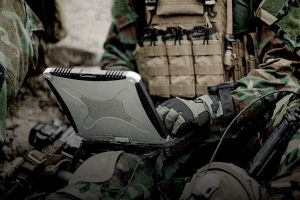 Military and government personnel are continually tasked with understanding and operating ever more technologically advanced weapons, communications and other systems. They are constantly looking for integrated solutions that are compact, easily deployable and secure, but also simple to use with a minimal learning curve.
Military and government personnel are continually tasked with understanding and operating ever more technologically advanced weapons, communications and other systems. They are constantly looking for integrated solutions that are compact, easily deployable and secure, but also simple to use with a minimal learning curve.
Robert Demers, Senior Advisor at Thuraya, says: “Government users face increasingly complex gadgetry every day. Each new electronic box or terminal has more buttons and complications than the one it replaced. Government users demand something simple and seamless that works every time – but that also functions as well in the dusty terrains of North Africa as in the rainy tropics of the Philippines.”
“We have witnessed a gradual evolution of the mobile communications requirements of military and other government customers over the past few years. The conflicts in Afghanistan and Iraq coincided with the coming of age of the digital generation. Men and women entering government and military service today have only known a world in which they are always connected to their peers by a device that fits into a pocket. The need and demand for mobility in the field has led to a revolution in on-the-go communications, supported by satellite.”
The recent security challenges, whether regional or worldwide, are the drivers for both military and law enforcement organisations to consider secure communication platforms within and behind a country’s borders. These needs have firmly positioned the satellite industry, whether it’s military or commercial payloads, as sometimes the only reliable platform.
Riyadh Al Adely, MD, Skystream, says today, more than ever, secure communications are essential.
“It is vital for maintaining homeland security, protecting the lives of citizens from the threats that have sadly intensified these days, managing waves of refugees and responding to damage caused by natural disasters. Satellite solutions are increasingly the preferred medium of choice for governments seeking the most secure, reliable, quick deploy transmission paths and cost-effective solutions.
“Sometimes satellite networks also tend to be less vulnerable to natural and man-made disasters than telephone lines and radio towers. This is why governments and businesses worldwide are adopting satellite technology for some important ‘must not fail’ communications missions.”
Moreover, government and militaries were previously happy to simply buy a fixed number of transponders on a satellite. This has changed incredibly in our increasingly connected world. It is also not necessary for all military and law enforcement applications to only use military payloads. Sometimes conventional commercial payloads can serve certain applications much better and overcome to a certain extent budget challenges.
Al Adely says: “The application and the budget are the main selection criteria between military and commercial payloads. If the application is to extend tactical networks beyond its coverage, then we are limited to certain military types of satellites, such as UHF, L-band or X-band, while other applications may require simple connectivity and conventional satellite can be the perfect fit.”
A few years ago the industry offered customers commercial off-the-shelf equipment, but as devices have become more complicated, simply delivering equipment like this doesn’t work anymore. Many military units don’t have personnel with the technical expertise to effectively put a communications network together. In fact, many military units around the world rely on staff contractors to maintain and update all varieties of equipment.
Demers says: “The problem with having the equipment but not the capability was driven home most tragically by the 2014 disappearance of AirAsia 8501 on a flight from Indonesia to Singapore. Indonesian ships and airplanes had radios to communicate with one another, but not the satellite connectivity essential to coordinating the overall search effort in the Java Sea from a central location. In a matter of hours, we were able to provide Thuraya IP satellite terminals and a link back to the primary coordination centre in Jakarta, so that the radios could be used to communicate search progress and ultimately help officials find the submerged wreckage of the aircraft.”
“Getting one type of information to integrate with another, such as coupling radar signals and surveillance video, has become mandatory for many government agencies tasked with monitoring vast geographic areas for terrorist or other threats. Such efforts create large networks of many small devices. These networks are not unlike an iPhone being used to adjust a home thermostat, turn on the TV or monitor the home security system. But these large government-operated monitoring networks require satellites in order to seamlessly connect devices, especially if they are in motion.”
Bandwidth and Applications
Al Adely says application, budget and availability of services over the targeted region determine the type of payload and the required spectrum. In order to backhaul a tactical network to another region beyond its coverage without losing mobility, network encryption, ease of use and light weight, services are limited to either UHF tactical satellites such as Airbus SkyNet or Inmarsat LTAC services. Other applications may require military satellite with different bands which can support higher throughput with anti-jamming features – in this case military Ka- or X-band satellites are used – but that’s not all; sometimes commercial, C-, Ku- or Ka-band are considered for certain applications.
Military business has seen significant growth in the last five years in the region, due to unfortunate circumstances that have created the need to respond to challenges. This demand is not limited to only space segments; it also includes terminals, systems integration and others. Ground stations, hubs and terminals have to cope with the applications. For mission-critical applications, all equipment has to be military certified and serve the purpose of the application.
“Militaries needed to evolve. The need for a secure, always-available network and accurate information became a crucial element to have an effective and successful operation. Satellites were one of the reliable communication methods. Mobility is one of the main applications we are delivering to our clients to service many areas such as border control, navies and operations in battlefields,” says Al Adely.
He adds: “SkyStream Defence had partnered with both Airbus Defence to promote Skynet tactical service and Inmarsat LTAC service that has positioned SkyStream as one of the few qualified providers for tactical satellite communications in the region. SkyStream Defence got involved in projects that require consultancies, network design and implementation to manage many applications for different troops. Iraq and Afghanistan were the anchor countries when we started the business; the US military and the local internet requirement was our focus at that time. Today the situation is not the same. We have evolved since then, our main focus is to be a solid player for military. The market response has indicated that we are on the right path.”
All space providers understand the need for a reliable, always-available link to serve the required military application. Military applications are mission-critical, and high availability is an important feature for any proposed links. Anti-jamming is one of the satellite features that will increase availability. Those features will mitigate the effect of deliberate and non-deliberate jamming.
Martin Coleman, Executive Director, the Satellite Interference Reduction Group, says: “Currently, most interference support and protection is driven by satellite operators. There is a genuine drive to keep the continuous development of ideas, process and technology to ensure we have all the tools in place to make resolution faster and more efficient, and that in turn helps address all issues when they occur, or ideally prevent them from happening in the first place.”
“This involves the constant analysis and identification of the source, types and characterisation of interference. It also involves monitoring to try and identify potential interference before it has an effect. However, probably the single most important aspect here is that the satellite operators work together and between many of the key players to resolve interference. Further effort is being directed to enhance the use of future technology ideas, such as software definition and cognitive computing, to add to both ground infrastructure and within the satellite constellations themselves,” concludes Coleman.














Add Comment